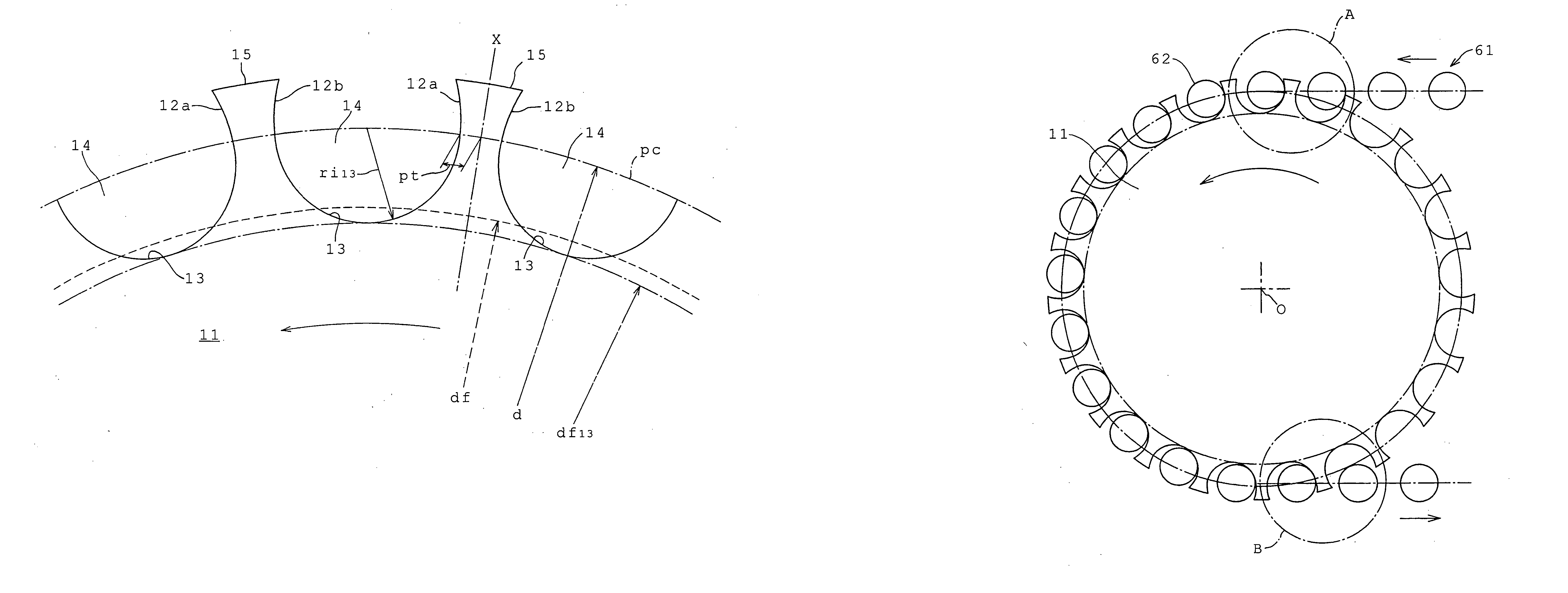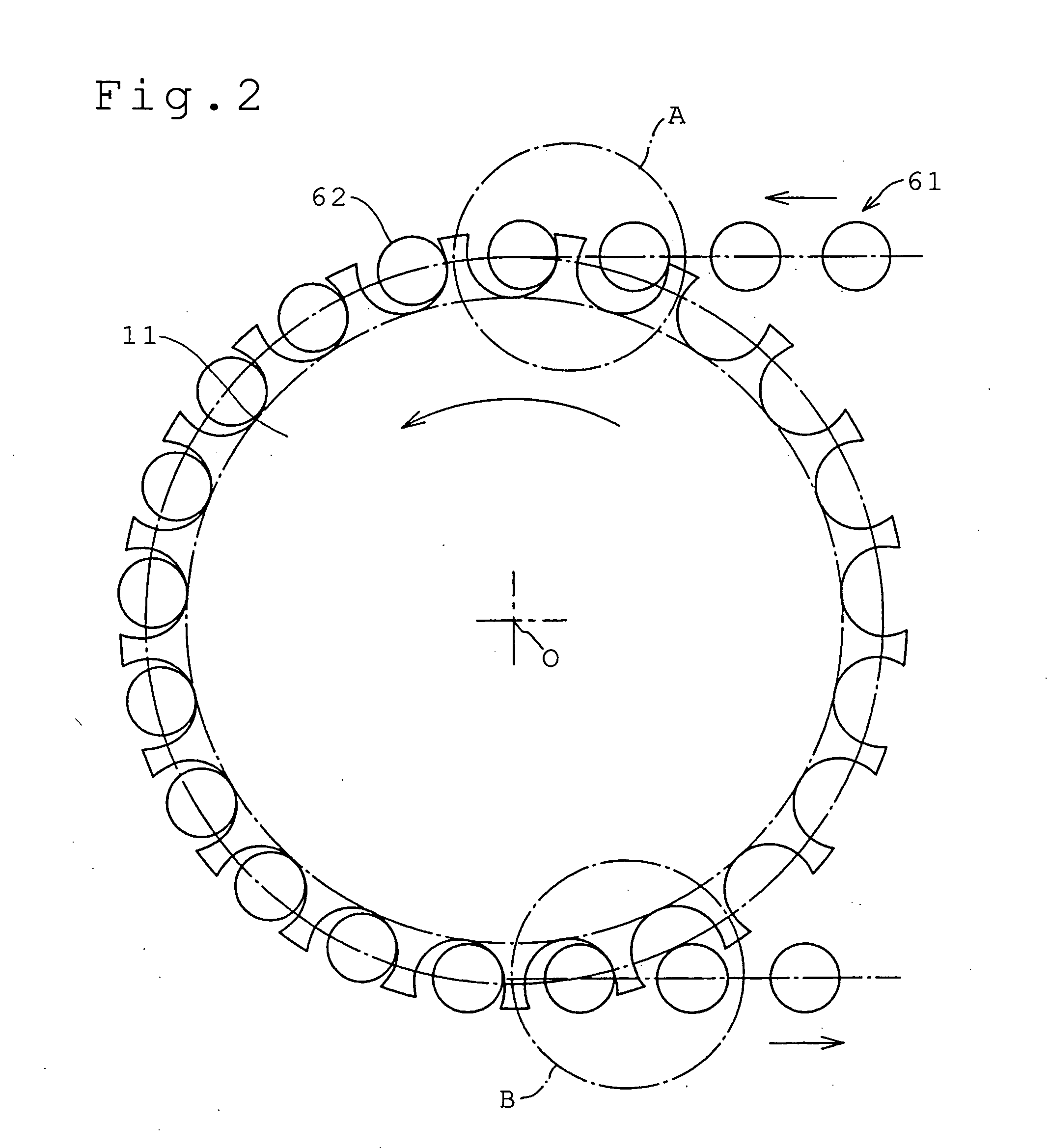Sprocket for chain
a chain and socket technology, applied in the direction of driving chains, gearing, hoisting equipment, etc., can solve the problems of noise generation, and achieve the effect of reducing the magnitude of the pulse motion of the roller chain or the bushing chain due to polygonal motion, reducing vibration and reducing the speed change speed of the roller chain or the bushing chain
- Summary
- Abstract
- Description
- Claims
- Application Information
AI Technical Summary
Benefits of technology
Problems solved by technology
Method used
Image
Examples
second embodiment
[0039] In the second embodiment, illustrated in FIGS. 5, 6 and 7, teeth 25 are separated by tooth grooves 24, in which facing tooth surfaces 22a and 22b are continuously connected to each other by tooth gap bottom portion 23.
[0040] A front tooth surface 22a and a rear tooth surface 22b are symmetrical on the right and left sides of the center line x of the tooth 25. Each of the tooth surfaces 22a and 22b has a substantially convex curve. Furthermore, the tooth gap bottom portion 23 is arc-shaped, with an arc radius ri23. The tooth surface 22a and tooth surface 22b, both of which have a substantially convex curve, are smoothly and continuously connected to each other by the tooth gap bottom portion 23.
first embodiment
[0041] As in the case of the first embodiment, in the embodiment shown in FIG. 5, the tooth form in the sprocket has portions, on the tooth head side of the pitch circle pc, where distances from the center line x to the front tooth surface 22a, and to a rear tooth surface 22b, are larger than the distance pt in the pitch circle pc.
[0042] The diameter df23 of the tooth gap bottom circle is also smaller than the diameter df of a tooth gap bottom circle in an ISO tooth form. That is, df23
[0043] As shown in FIG. 6, while a preceding roller 62a is engaged with the sprocket 21 in a tooth groove 24, the following roller 62b is engaged with a front tooth surface 22a. As in the case of the first embodiment, the center of the preceding roller 62a and the center of the following roller 62b are positioned on the same horizontal line. Furthermore, altho...
third embodiment
[0046] In the third embodiment, illustrated in FIGS. 8, 9, and 10, teeth 35 are separated by tooth grooves 34, in which facing tooth surfaces 32a and 32b are continuously connected to each other by tooth gap bottom portion 33.
[0047] A front tooth surface 32a and a rear tooth surface 32b are symmetrical on the right and left sides of the center line x of the tooth 35. In this embodiment, the faces of the teeth outside the pitch circle are linear in cross section, and the tooth surfaces 32a and 32b are in the form of substantially parallel planes. Furthermore, the tooth gap bottom portion 33 is arc-shaped, with an arc radius ri33. The tooth surface 32a and tooth surface 32b, both of which are substantially planar, are smoothly and continuously connected to each other by the tooth gap bottom portion 33.
[0048] In this case, the tooth form in the sprocket has portions, on the tooth head side of the pitch circle pc, where distances from the center line x to the front tooth surface 32a, a...
PUM
 Login to View More
Login to View More Abstract
Description
Claims
Application Information
 Login to View More
Login to View More - R&D
- Intellectual Property
- Life Sciences
- Materials
- Tech Scout
- Unparalleled Data Quality
- Higher Quality Content
- 60% Fewer Hallucinations
Browse by: Latest US Patents, China's latest patents, Technical Efficacy Thesaurus, Application Domain, Technology Topic, Popular Technical Reports.
© 2025 PatSnap. All rights reserved.Legal|Privacy policy|Modern Slavery Act Transparency Statement|Sitemap|About US| Contact US: help@patsnap.com



